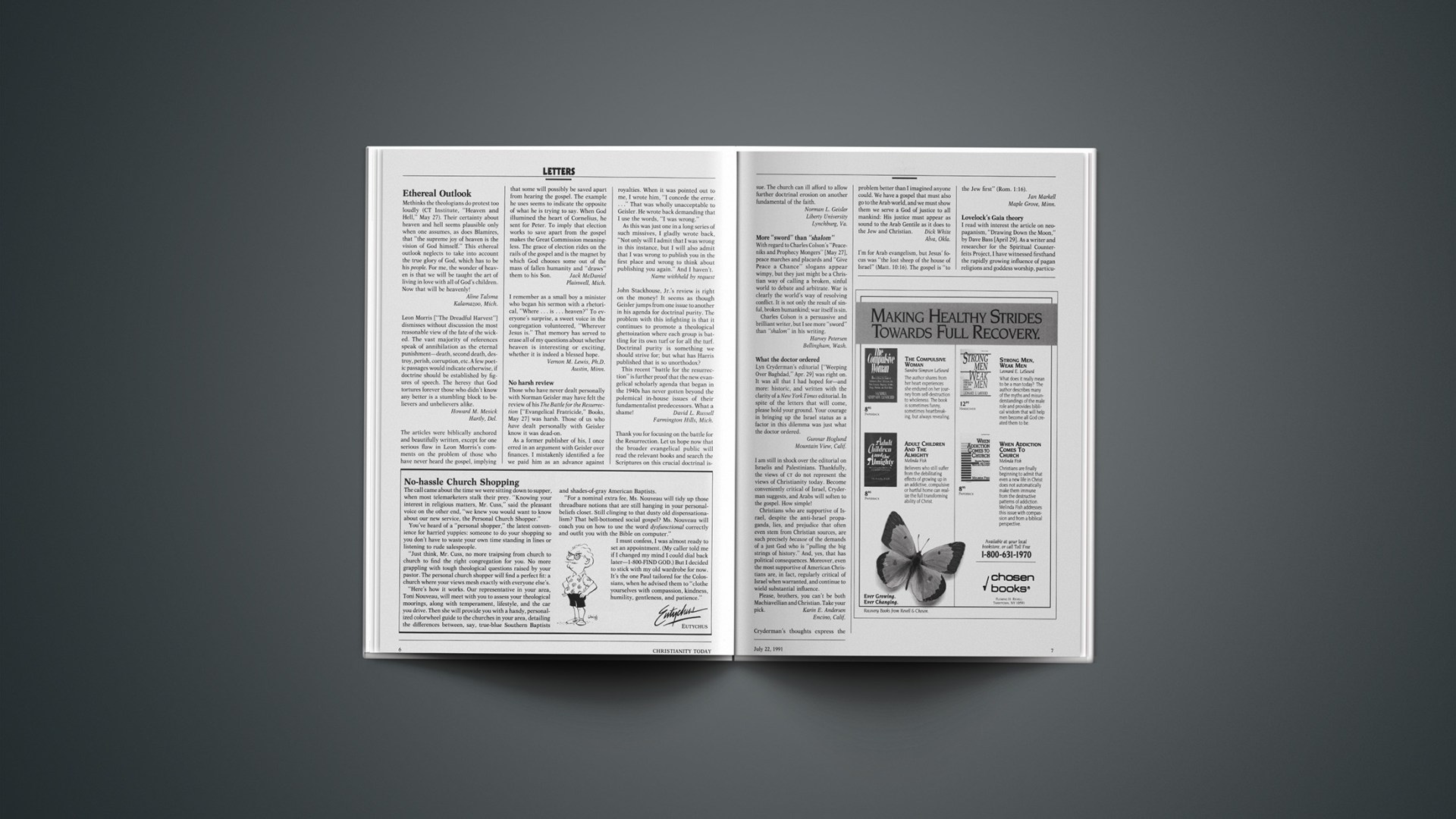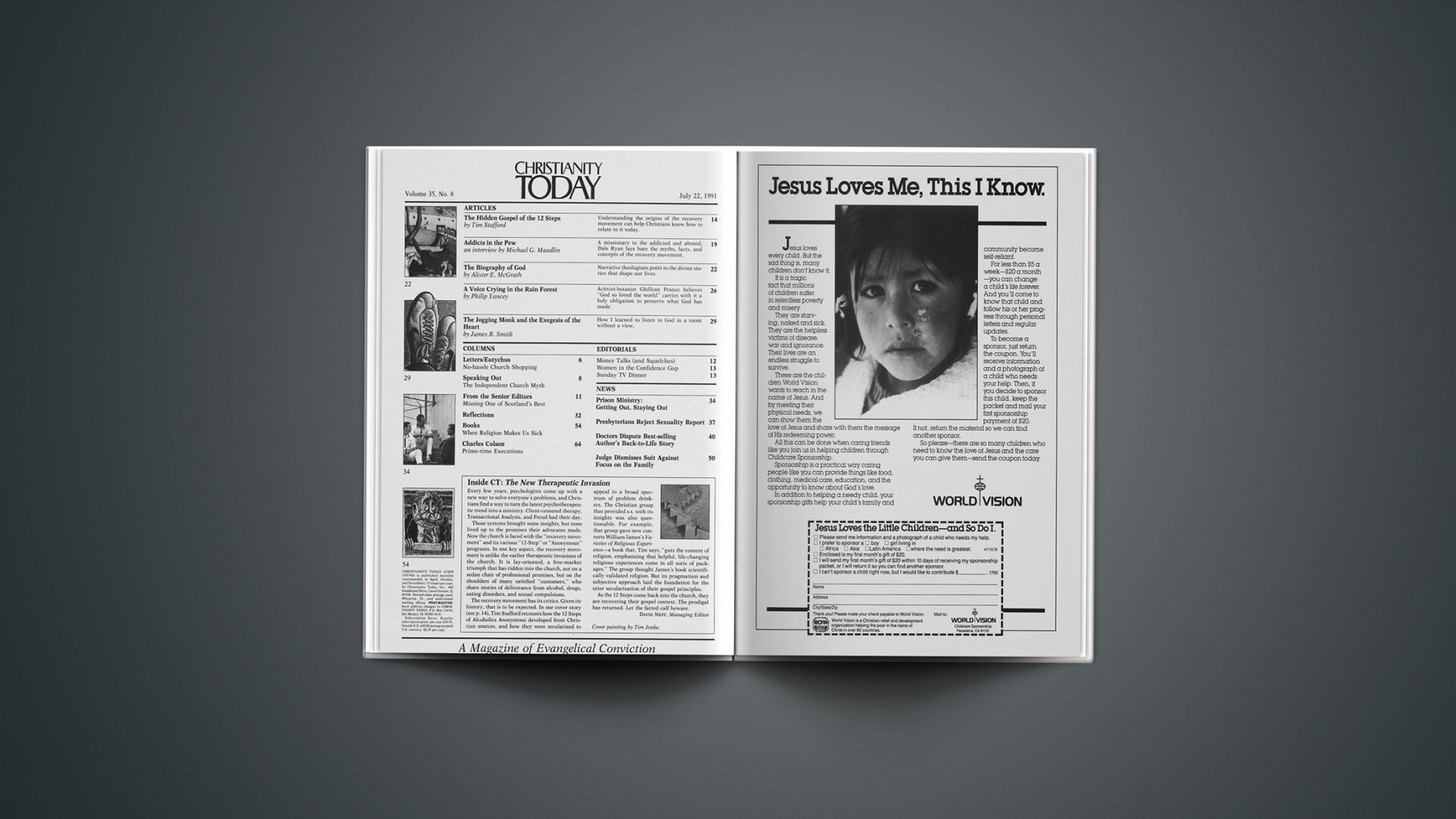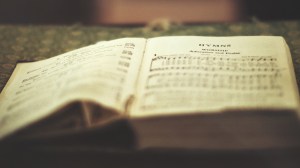Ethereal Outlook
Methinks the theologians do protest too loudly (CT Institute, “Heaven and Hell,” May 27). Their certainty about heaven and hell seems plausible only when one assumes, as does Blamires, that “the supreme joy of heaven is the vision of God himself.” This ethereal outlook neglects to take into account the true glory of God, which has to be his people. For me, the wonder of heaven is that we will be taught the art of living in love with all of God’s children. Now that will be heavenly!
Aline Talsma
Kalamazoo, Mich.
Leon Morris [“The Dreadful Harvest”] dismisses without discussion the most reasonable view of the fate of the wicked. The vast majority of references speak of annihilation as the eternal punishment—death, second death, destroy, perish, corruption, etc. A few poetic passages would indicate otherwise, if doctrine should be established by figures of speech. The heresy that God tortures forever those who didn’t know any better is a stumbling block to believers and unbelievers alike.
Howard M. Mesick
Hardy, Del.
The articles were biblically anchored and beautifully written, except for one serious flaw in Leon Morris’s comments on the problem of those who have never heard the gospel, implying that some will possibly be saved apart from hearing the gospel. The example he uses seems to indicate the opposite of what he is trying to say. When God illumined the heart of Cornelius, he sent for Peter. To imply that election works to save apart from the gospel makes the Great Commission meaningless. The grace of election rides on the rails of the gospel and is the magnet by which God chooses some out of the mass of fallen humanity and “draws” them to his Son.
Jack McDaniel
Plainwell, Mich.
I remember as a small boy a minister who began his sermon with a rhetorical, “Where … is … heaven?” To everyone’s surprise, a sweet voice in the congregation volunteered, “Wherever Jesus is.” That memory has served to erase all of my questions about whether heaven is interesting or exciting, whether it is indeed a blessed hope.
Vernon M. Lewis, Ph.D.
Austin, Minn.
No harsh review
Those who have never dealt personally with Norman Geisler may have felt the review of his The Battle for the Resurrection [“Evangelical Fratricide, “Books, May 27] was harsh. Those of us who have dealt personally with Geisler know it was dead-on.
As a former publisher of his, I once erred in an argument with Geisler over finances. I mistakenly identified a fee we paid him as an advance against royalties. When it was pointed out to me, I wrote him, “I concede the error.…” That was wholly unacceptable to Geisler. He wrote back demanding that I use the words, “I was wrong.”
As this was just one in a long series of such missives, I gladly wrote back, “Not only will I admit that I was wrong in this instance, but I will also admit that I was wrong to publish you in the first place and wrong to think about publishing you again.” And I haven’t.
Name withheld by request
John Stackhouse, Jr.’s review is right on the money! It seems as though Geisler jumps from one issue to another in his agenda for doctrinal purity. The problem with this infighting is that it continues to promote a theological ghettoization where each group is battling for its own turf or for all the turf. Doctrinal purity is something we should strive for; but what has Harris published that is so unorthodox?
This recent “battle for the resurrection” is further proof that the new evangelical scholarly agenda that began in the 1940s has never gotten beyond the polemical in-house issues of their fundamentalist predecessors. What a shame!
David L. Russell
Farmington Hills, Mich.
Thank you for focusing on the battle for the Resurrection. Let us hope now that the broader evangelical public will read the relevant books and search the Scriptures on this crucial doctrinal issue. The church can ill afford to allow further doctrinal erosion on another fundamental of the faith.
Norman L. Geisler
Liberty University Lynchburg, Va.
More “sword” than “shalom”
With regard to Charles Colson’s “Peaceniks and Prophecy Mongers” [May 27], peace marches and placards and “Give Peace a Chance” slogans appear wimpy, but they just might be a Christian way of calling a broken, sinful world to debate and arbitrate. War is clearly the world’s way of resolving conflict. It is not only the result of sinful, broken humankind; war itself is sin.
Charles Colson is a persuasive and brilliant writer, but I see more “sword” than “shalom” in his writing.
Harvey Petersen
Bellingham, Wash.
What the doctor ordered
Lyn Cryderman’s editorial [“Weeping Over Baghdad,” Apr. 29] was right on. It was all that I had hoped for—and more; historic, and written with the clarity of a New York Times editorial. In spite of the letters that will come, please hold your ground. Your courage in bringing up the Israel status as a factor in this dilemma was just what the doctor ordered.
Gunnar Hoglund
Mountain View, Calif.
I am still in shock over the editorial on Israelis and Palestinians. Thankfully, the views of CT do not represent the views of Christianity today. Become conveniently critical of Israel, Cryderman suggests, and Arabs will soften to the gospel. How simple!
Christians who are supportive of Israel, despite the anti-Israel propaganda, lies, and prejudice that often even stem from Christian sources, are such precisely because of the demands of a just God who is “pulling the big strings of history.” And, yes, that has political consequences. Moreover, even the most supportive of American Christians are, in fact, regularly critical of Israel when warranted, and continue to wield substantial influence.
Please, brothers, you can’t be both Machiavellian and Christian. Take your pick.
Karin E. Andersen
Encino, Calif.
Cryderman’s thoughts express the problem better than I imagined anyone could. We have a gospel that must also go to the Arab world, and we must show them we serve a God of justice to all mankind: His justice must appear as sound to the Arab Gentile as it does to the Jew and Christian.
Dick White
Alva, Okla.
I’m for Arab evangelism, but Jesus’ focus was “the lost sheep of the house of Israel” (Matt. 10:16). The gospel is “to the Jew first” (Rom. 1:16).
Jan Markell
Maple Grove, Minn.
Lovelock’s Gaia theory
I read with interest the article on neopaganism, “Drawing Down the Moon,” by Dave Bass [April 29]. As a writer and researcher for the Spiritual Counterfeits Project, I have witnessed firsthand the rapidly growing influence of pagan religions and goddess worship, particularly in the form of Gaia worship. However, Bass’s reference to Lovelock’s Gaia Hypothesis as “strictly materialist” is not quite accurate. Lovelock’s Gaia theory is steeped in mystical and spiritual concepts and ideas.
Stuart Chevre
Berkeley, Calif.
Like oil and water
The article “We Believe” by Andrew Walker in the April 29 issue presents an important topic—unity among “God’s family.” However, Walker’s highly simplistic solution has totally missed the foundation upon which unity must be anchored. He includes among “God’s family,” to name three, Roman Catholicism, Eastern Orthodoxy, and evangelicalism. These three go together like oil and water! According to Roman Catholicism and Eastern Orthodoxy, one becomes a member of God’s family by faith and works. Evangelicalism believes that one becomes a member of God’s family by God’s grace through faith alone and that works are the evidence and the natural result of God’s transforming grace in a person’s life. How can Walker include Roman Catholicism and Eastern Orthodoxy in God’s family when their belief system contradicts the sure apostolic record?
Stephen J. Celich, Jr.
Wexford, Pa.
After the Gulf War it occurred to me that the church—like the Iraqi army—routinely shoots its own troops, then eagerly surrenders to the enemy. Walker’s article highlights this fact, and seems also to say that heresy consists of a violence committed against the “core of Christian orthodoxy.”
A fellow traveler on that “great viaduct,” who deviates from my views on relatively peripheral concerns such as eschatology, ecclesiology, politics, or even (heaven help us) women’s roles, is not a “heretic,” not my enemy, and therefore not someone I ought to shoot.
Rebecca Groothuis
Eugene, Oreg.
Destroying America’s soul
Philip Yancey’s searching and thoughtful column “How We Became the ‘Great Satan’ ” [April 29] reminded me of the conversation between Malcolm Muggeridge and Graham Greene. As he told it, “Graham Greene talked a lot about how Russian domination would be less terrible than American. [Muggeridge] mentioned the church, and he said Russians only destroy its body, whereas Americans destroy its soul.” As George MacDonald wrote, “A beast does not know that he is a beast, and the nearer a man gets to being a beast the less he knows of it.”
Ian S. Munday
Victoria, B.C., Canada
LAPD brutality
I take strong exception to certain comments by Los Angeles assistant police chief Robert Vernon [News, April 29]. He plants his feet on a blind submission to government, then makes his exception: when the government orders a direction opposed to what God specifically has told us to do. He is in the right direction here, but fails to understand Calvin and Augustine along this path—or, in fact, Paul. My objection to his reasoning begins when he excuses the brutal treatment of Operation Rescue activists by the L.A. police—which produced no national outcry—for their crime of violating some law of, I assume, trespass, then lying about their names.
It was with such reasoning that Germans produced Adolf Hitler and the Nazis in the 1930s.
Vernon is troubled about the beating of the hapless black beaten by his police. I hope he will examine himself with regard to the brutality encouraged by his police on the people who obeyed the Lord by trying to save innocent life. Or is that not specifically commanded by the Lord?
C. R. Stegall
Jacksonville, Fla.
Vernon misrepresented Operation Rescue. First, rescuers do not resist arrest. They become passively limp. Second, rescuers do not “lie” by occasionally identifying themselves as “Baby Doe.” Authorities usually understand this gesture as part of the rescuers’ identification with nameless slaughtered children. Furthermore, the amount of force employed by L.A. police to remove passive protestors far exceeds the amount necessary.
It is heartbreaking that evangelical prolifers like Vernon and his pastor take a public stand against their brothers and sisters in the rescue movement. The least they can do is get their facts right.
Pastor Ken Langley
Island Baptist Church
Beach Haven, N.J.
Why didn’t Vernon go to the Word of God first, instead of to his church elders? Vernon evidently forgot his belief that when laws are wrong, “we ought to obey God rather than men.”
Mrs. Edith Manchester
Santa Cruz, Calif.
The call came about the time we were sitting down to supper, when most telemarketers stalk their prey. “Knowing your interest in religious matters, Mr. Cuss,” said the pleasant voice on the other end, “we knew you would want to know about our new service, the Personal Church Shopper.”
You’ve heard of a “personal shopper,” the latest convenience for harried yuppies: someone to do your shopping so you don’t have to waste your own time standing in lines or listening to rude salespeople.
“Just think, Mr. Cuss, no more traipsing from church to church to find the right congregation for you. No more grappling with tough theological questions raised by your pastor. The personal church shopper will find a perfect fit: a church where your views mesh exactly with everyone else’s.
“Here’s how it works. Our representative in your area, Toni Nouveau, will meet with you to assess your theological moorings, along with temperament, lifestyle, and the car you drive. Then she will provide you with a handy, personalized colorwheel guide to the churches in your area, detailing the differences between, say, true-blue Southern Baptists and shades-of-gray American Baptists.
“For a nominal extra fee, Ms. Nouveau will tidy up those threadbare notions that are still hanging in your personal-beliefs closet. Still clinging to that dusty old dispensationalism? That bell-bottomed social gospel? Ms. Nouveau will coach you on how to use the word dysfunctional correctly and outfit you with the Bible on computer.”
I must confess, I was almost ready to set an appointment. (My caller told me if I changed my mind I could dial back later—1–800-FIND GOD.) But I decided to stick with my old wardrobe for now. It’s the one Paul tailored for the Colossians, when he advised them to “clothe yourselves with compassion, kindness, humility, gentleness, and patience.”
EUTYCHUS






